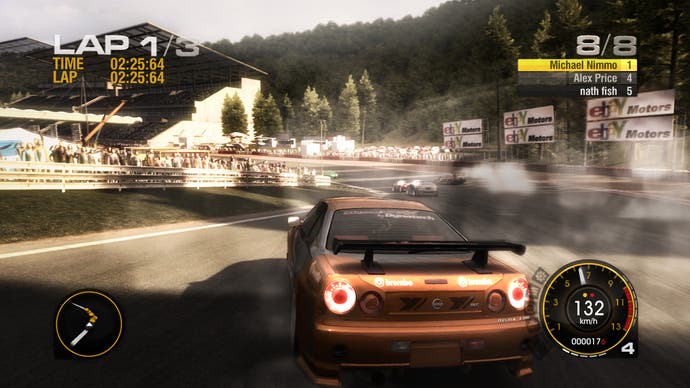Race Driver: GRID Multiplayer
Competitive.
Playing Race Driver: GRID online with eleven of Codemasters' finest developers, QA testers and PR people, we find something unfamiliar running through our head. It's a Dodge Viper. This happens quite a lot, and this particular one has just knocked off our bumper, but more immediately worrying is that it's flipped our car onto its back and crippled the engine. Thanks for that.
GRID isn't the first online racing game to include measurable car damage, but it is the first to do it this extensively. Damage is modelled for individual wheels and various key areas of the car, with icons in the bottom-right of the HUD to indicate damage levels, and Codemasters has spent a lot of time making sure damage synchronises properly between consoles connected over the Internet, so that when you bang into someone's passenger door, they veer off-course into a tyre wall at exactly the right time. Nothing's been lost in translation. In fact, the only discernible difference between what happens when a computer-controlled Dodge Viper lands on your head and when a human one does is that the host had the option to disable damage modelling before the game began.
More significant even than that for the game overall, though, is that GRID's emerging with full damage on PS3, Xbox 360 and PC just as Polyphony Digital makes its first fumbling steps online in Gran Turismo 5 Prologue (which will introduce damage-modelling at some undetermined point in the future), and just as enthusiasm wanes for last year's Xbox 360 duo of Forza Motorsport 2 (number ten in the last Xbox Live chart) and, unquestionably GRID's most direct rival, Project Gotham Racing 4. Unlike our friend with the flying Viper, then, GRID's is a timely intervention.

So it's no surprise to see the team really going for it online. Every single-player event and discipline will be accessible, for a total of 32 events across 80 circuits in 15 different locations, including Milan, San Francisco and Tokyo. You can create and search for Ranked and Player Matches specifying region (Europe/Japan/USA/Global) and event, whether damage or catch-up are enabled, and how long the race goes on for. If you're setting up a Private Match, you can also specify racetracks and even particular routes around those racetracks before inviting your friends to join in, and complete wimps can allow for driver assists like traction control. When you first gather in the lobby, grid position is determined by who makes themselves ready first, with subsequent grids in the series determined by the finishing order of the first race.
We begin our session with damage disabled in a straight race around a small Milanese circuit that skirts the front of that handsome cathedral we mentioned last time we went hands-on with GRID. This doesn't go smoothly (I knocked the 360 off the table - don't tell anyone), but it's interesting to compare the experience to what happens when we resume in a muscle car tussle around San Francisco. As a procession of Mustangs pile toward the first corner, we brace ourselves for the inevitable; good, competitive online races are seldom decided at the first corner, but the tone of what follows and the layout of the pack often is, as everyone smashes into each other, aware of the random factor. But, in GRID's case, while a handful of us at the back obliterate one another, it's a short-lived thrill. Two cars are completely totalled, and those drivers have no option but to sit and watch for the next three laps, jabbering into their headsets. Those at the front of the pack, however, have borne the threat of destruction in mind and fought one another fairly for position. Over the course of the races we take part in, the players who are best at the actual game are the most frequent victors.


